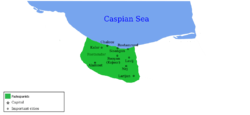Paduspanids
The Paduspanids or Baduspanids (Persian: پادوسبانیان) were a local dynasty of Tabaristan which ruled over Royan, Nur and Rostamdar. The dynasty was established in 655,[1] and ended in 1598 when the Safavids invaded their domains.[2]
Paduspanid dynasty پادوسبانیان | |||||||||
|---|---|---|---|---|---|---|---|---|---|
| 655–1598 | |||||||||
 Map of the normal domains of the Paduspanids in Tabaristan | |||||||||
| Common languages | Persian Caspian languages | ||||||||
| Religion | Zoroastrianism (655-9th-century) Islam (9th-century-1598) | ||||||||
| Government | Monarchy | ||||||||
| Ispahbadh Ustandar Malek | |||||||||
• 665–694 | Paduspan I (first) | ||||||||
• 1590–1598 | Jahangir IV (last) | ||||||||
| Historical era | Middle Ages | ||||||||
• Established | 655 | ||||||||
• Safavid conquest | 1598 | ||||||||
| |||||||||
History
The founder of the Paduspanid dynasty was Paduspan I, (also known by the Arabicized form Baduspan), who was the son of Gil Gavbara,[2] the founder of the Dabuyid dynasty. Thus making the Paduspanids of Sasanian descent like the Dabuyids.
Known Paduspanid rulers
- 655-694 : Paduspan I
- 694-723 : Khur-zad
- 723-762 : Paduspan II
- 762-791 : Shahriyar I ibn Paduspan
- 791-822 : Wandad Umid
- 822-855 : Abdallah ibn Wandad
- 855-??? : Faridun ibn Qarin
- ???-??? : Paduspan III
- ???-??? : Shahriyar II ibn Paduspan
- 887-899 : Hazar Sandan
- 899-938 : Shahriyar III ibn Jamshid
- 938-965 : Shams al-Muluk Muhammad
- 965-??? : Istwandad
- ????-???? : Fakhr al-Dawla Namavar I
- ????-1117 : Hazarasp I
- 1117-1168 : Shahrivash
- 1168-1184 : Kai Ka'us I
- 1184-1190 : Hazarasp II
- 1190-1209 : Bavandid occupation
- 1209-1213 : Zarrinkamar
- 1213 -1223 : Bisotun I
- 1223-1242/1243 : Fakhr al-Dawla Namavar II
- Mort en 1242 : Hosam al-Dawla Ardashir
- 1242- ???? : Eskandar I
- 1242-1272 : Shahragim
- 1272-1301 : Fakr-al-Dawla Namavar III Shah-Ghazi
- 1301-1311 : Kai-Khosrow
- 1311-1317 : Shams al-Muluk Mohammad
- 1317-1324 : Nasir al-Din Shahriyar
- 1324-1333 : Taj al-Dawla Ziyar
- 1333-1359 : Eskandar II
- 1359-1378 : Fakhr al-Dawla Shah-Ghazi
- 1378-1379 : Azod al-Dawla Qobad
- 1379-1391 : Marashiyan occupation
- 1391-1394 : Sa'd al-Dawla Tus
- 1394- : Eskandar III
- 1399-1453 : Kayumarth I
- 1453 : Kayumarth II
Nur branch
- 1453-1467 : Ka'us II
- 1467-1499 : Jahangir I
- 1499-1507 : Bisotun II
- 1507-1550 : Bahman of Tabaristan
- 1550-1576 : Kayumarth IV
- 1582-1586 : Sultan Aziz
- 1586-1593/1594 : Jahangir III
Kojur branch
- 1453-1476 : Eskandar IV
- 1476-1491 : Taj-al-Dawla ibn Eskandar
- 1491-1507 : Ashraf ibn Taj al-Dawla
- 1507-1543 : Ka'us III
- 1543-1555 : Kayumarth III
- 1555-1567 : Jahangir II
- 1568-1590 : Sultan Mohammad ibn Jahangir
- 1590-1598 : Jahangir IV
gollark: I see.
gollark: They aren't really very writable, so I don't think I'd want to use them for boot disks.
gollark: Although blu-rays are more capacious.
gollark: They're still probably useful for write-once backups.
gollark: Use a Raspberry Pi, obviously.
References
- The Political and Dynastic History of the Iranian World (A.D. 1000-1217), C.E. Bosworth, The Cambridge History of Iran, Volume 5, ed. J. A. Boyle, John Andrew Boyle, (Cambridge University Press, 2001), 29.
- BADUSPANIDS, W. Madelung, Encyclopaedia Iranica
Sources
- Frye, R.N. (1968). "The Saljuq and Mongol periods". In Boyle, John Andrew (ed.). The Cambridge History of Iran, Volume 5: The Saljuq and Mongol Periods. Cambridge: Cambridge University Press. pp. 1–659. ISBN 0-521-06936-X.
- Madelung, W. (2010). "BADUSPANIDS". Encyclopaedia Iranica, Online Edition. Retrieved 20 January 2014.
- Madelung, W. (1975). "The Minor Dynasties of Northern Iran". In Frye, Richard N. (ed.). The Cambridge History of Iran, Volume 4: From the Arab Invasion to the Saljuqs. Cambridge: Cambridge University Press. pp. 198–249. ISBN 0-521-20093-8.
Further reading
- Ghereghlou, Kioumars (2018). "Bādūsbānids". In Fleet, Kate; Krämer, Gudrun; Matringe, Denis; Nawas, John; Rowson, Everett (eds.). Encyclopaedia of Islam, THREE. Brill Online. ISSN 1873-9830.
This article is issued from Wikipedia. The text is licensed under Creative Commons - Attribution - Sharealike. Additional terms may apply for the media files.

